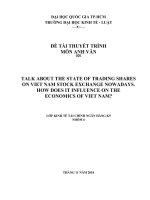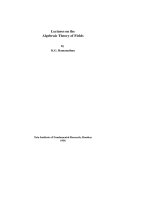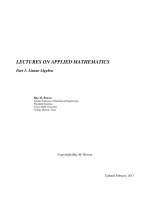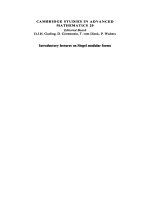Lectures on urban economics
Bạn đang xem bản rút gọn của tài liệu. Xem và tải ngay bản đầy đủ của tài liệu tại đây (1.34 MB, 296 trang )
Lectures on Urban Economics
Lectures on Urban Economics
Jan K. Brueckner
The MIT Press
Cambridge, Massachusetts
London, England
© 2011 Massachusetts Institute of Technology
All rights reserved. No part of this book may be reproduced in any form by any electronic
or mechanical means (including photocopying, recording, or information storage and
retrieval) without permission in writing from the publisher.
For information on special quantity discounts, email
Set in Palatino by Toppan Best-set Premedia Limited. Printed and bound in the United
States of America.
Library of Congress Cataloging-in-Publication Data
Brueckner, Jan K.
Lectures on urban economics / Jan K. Brueckner.
p. cm.
Includes bibliographical references and index.
ISBN 978-0-262-01636-0 (pbk. : alk. paper)
1. Urban economics. I. Title.
HT321.B78 2011
330.09173'2—dc22
2011006524
10
9
8
7
6
5
4
3
2
1
Contents
Preface
1
1.1
1.2
1.3
1.4
1.5
1.6
1.7
2
2.1
2.2
2.3
2.4
2.5
2.6
2.7
2.8
3
3.1
3.2
3.3
3.4
3.5
3.6
3.7
ix
Why Cities Exist 1
Introduction 1
Scale Economies 2
Agglomeration Economies 5
Transport Costs and Firm Location 10
The Interaction of Scale Economies and Transportation Costs in the
Formation of Cities 16
Retail Agglomeration and the Economics of Shopping Centers 18
Summary 20
Analyzing Urban Spatial Structure
Introduction 23
Basic Assumptions 25
Commuting Cost 26
Consumer Analysis 27
Analysis of Housing Production 33
Population Density 39
Intercity Predictions 42
Summary 50
23
Modifications of the Urban Model 51
Introduction 51
A City with Two Income Groups 51
Commuting by Freeway 56
Adding Employment Outside the CBD 57
Durable Housing Capital 61
Cities in Developing Countries 65
Summary 68
vi
4
4.1
4.2
4.3
4.4
4.5
4.6
4.7
5
5.1
5.2
5.3
5.4
5.5
5.6
5.7
5.8
6
6.1
6.2
6.3
6.4
6.5
6.6
6.7
7
7.1
7.2
7.3
7.4
7.5
8
8.1
8.2
8.3
Contents
Urban Sprawl and Land-Use Controls 69
Introduction 69
Empirical Evidence on the Spatial Sizes of Cities 70
Market Failures and Urban Sprawl 73
Behavioral Impacts of Urban Sprawl 80
Using Land-Use Controls to Attack Urban Sprawl 80
Other Types of Land-Use Controls 84
Summary 89
Freeway Congestion
Introduction 91
Congestion Costs 92
91
The Demand for Freeway Use 95
Traffic Allocations: Equilibrium and Social Optimum
Congestion Tolls 104
Choice of Freeway Capacity 110
Application to Airport Congestion 112
Summary 114
99
Housing Demand and Tenure Choice 115
Introduction 115
Housing Demand: The Traditional and Hedonic Approaches
The User Costs of Housing 119
Tenure Choice 124
Down-Payment Requirements, Tenure Choice, and
Mortgage Default 130
Property Abuse and Tenure Choice 133
Summary 136
Housing Policies
Introduction 137
Rent Control 137
137
Housing-Subsidy Programs 145
Homelessness and Policies to Correct It
Summary 157
Local Public Goods and Services
Introduction 159
153
159
The Socially Optimal Level of a Public Good 161
Majority Voting and Voting with One’s Feet 163
116
Contents
vii
8.4
8.5
8.6
8.7
Public-Good Congestion and Jurisdiction Sizes 174
Capitalization and Property-Value Maximization 179
Tax and Welfare Competition 183
Summary 185
9
Pollution
9.1
9.2
9.3
9.4
9.5
9.6
Introduction 187
Pollution from a Single Factory and Governmental Remedies 188
Bargaining as a Path to the Social Optimum: The Coase Theorem 196
Cap-and-Trade Systems 200
Evidence on Air Pollution and Property Values 204
Summary 205
10
Crime
187
207
Introduction 207
The Economic Theory of Crime 208
Additional Aspects of the Theory 215
How to Divide a Police Force Between Rich and Poor
Neighborhoods 221
10.5 Summary 229
10.1
10.2
10.3
10.4
11
11.1
11.2
11.3
11.4
11.5
Urban Quality-of-Life Measurement
Introduction 231
Theory: The Roback Model 233
Measuring Urban Quality of Life 241
Additional Issues 244
Summary 245
Exercises 247
References 273
Index 281
231
Preface
This book offers a rigorous but nontechnical treatment of major topics
in urban economics. The book is directed toward several potential
audiences. It could be used as a main textbook, or possibly a supplementary book, in an undergraduate or master ’s-level urban economics
course. It could be used as background reading in a PhD-level course
in which students would also read technical journal articles. It could
also be read by economists or researchers in other fields seeking to
learn what urban economics is about.
To make the book accessible to a broad group of readers, the analysis
is mostly diagrammatic. A few chapters make use of some simple formulas and a bit of algebra, but calculus is almost absent. Even though
the treatment is nontechnical, the analysis of urban topics attempts to
rely on rigorous economic reasoning. The orientation is conceptual,
with each chapter presenting and analyzing economic models that are
relevant to the issue at hand. In contrast to the cursory theoretical
development often found in undergraduate textbooks, the various
chapters offer thorough and exhaustive treatments of the relevant
models, with the goal of exposing the logic of economic reasoning and
teaching urban economics at the same time. Because of its conceptual
orientation, the book contains very little purely descriptive or factual
material of the kind usually found in textbooks. Instructors wishing to
expose students to such material could supplement the book with other
readings. Some topics not associated with sharply defined models,
such as urban poverty, receive no coverage.
Exercises are presented at the back of the book, for possible use
when it is employed as an undergraduate text. They develop numerical
examples based on the models presented in the chapters. Footnotes
throughout the chapters point to exercises that are relevant to the
current discussion.
x
Preface
In view of the nature of the book, the list of references is not particularly extensive. No attempt is made to provide exhaustive citations of
the literature on each topic. Instead, one or two representative citations
might be given as part of the discussion of standard material that is
well accepted among urban economists. However, when a specific idea
advanced by a particular author is discussed, the appropriate citation
is included. Although the citations are not exhaustive, readers seeking
more exposure to a topic can always find references to the literature in
the works that are cited.
Since the book has grown out of my own research on a variety of
topics in urban economics, the references include an unavoidably large
number of my own papers. Other researchers should recognize that
this pattern does not reflect an opinion about relative contributions to
the field. Again reflecting my own interests within urban economics,
the book contains less material on the New Economic Geography, an
area of active research in the field since the early 1990s, than would a
book written by an NEG researcher. The material relevant to NEG is
confined to chapter 1.
The book’s suitability as a text for an undergraduate course in urban
economics, or for a series of such courses, would depend on the length
of the course(s). All the chapters can be covered in the undergraduate
urban sequence at UC Irvine, which runs for two quarters of 10 weeks
each. In a semester-length course of 15 weeks, some of the chapters
would have to be dropped, and only about half of the book could be
covered in single-quarter course.
This book has grown out of 30 years of teaching urban economics
to undergraduates and PhD students, and I’m grateful to all my students for the opportunity to refine my views on the subject. As for
assistance with the book itself, I’m indebted to Nilopa Shah, one of my
PhD students at UC Irvine, for her expert work in preparing the figures.
I also thank various reviewers for helpful suggestions that improved
the book in many places.
1
1.1
Why Cities Exist
Introduction
In most countries, the population is highly concentrated in a spatial
sense. For example, cities occupy only about 2 percent of the land area
of the United States, with the rest vacant or inhabited at very low
population densities. Even in countries that lack America’s wide-open
spaces, spatial concentration of the population can be substantial, with
much of the land vacant. This chapter identifies some forces that lead
to the spatial concentration of population. Thus, it identifies forces that
help to explain the existence of cities.
Depending on their orientation, different social scientists would
point to different explanations for the existence of cities. A military
historian, for example, might say that, unless populations are concentrated in cities (perhaps contained within high walls), defense against
attack would be difficult. A sociologist might point out that people
like to interact socially, and that they must be spatially concentrated
in cities in order to do so. In contrast, economic explanations for
the existence of cities focus on jobs and the location of employment.
Economists argue that certain economic forces cause employment
to be concentrated in space. Concentrations of jobs lead to concentrations of residences as people locate near their worksites. The result
is a city.
The two main forces identified by economists that lead to spatial
concentration of jobs are scale economies and agglomeration economies. With scale economies, also known as “economies of scale” or
“increasing returns to scale,” business enterprises become more efficient at large scales of operation, producing more output per unit of
input than at smaller scales. Scale economies thus favor the formation
of large enterprises. Since scale economies apply to a single business
2
Chapter 1
establishment (say, a factory), they favor the creation of large factories,
and thus they favor spatial concentrations of employment.1
Whereas scale economies operate within a firm, without regard to
the external environment, agglomeration economies are external to a
firm. Agglomeration economies capture the benefits enjoyed by a firm
when it locates amid other business enterprises. These benefits include
potential savings in input costs, which may be lower when many firms
are present, as well as productivity gains. A productivity effect arises
because inputs (particularly labor) may be more productive when a
firm locates amid other business enterprises rather than in an isolated
spot. The mechanisms underlying these effects will be explained later
in the chapter.
Transportation costs also influence where a firm locates, and they
can lead to, or reinforce, spatial concentration of jobs. This chapter
explains several different ways in which transportation costs affect the
formation of cities. The last section explores a special kind of agglomeration force: the kind that causes the clustering of retail establishments
and the creation of shopping malls.
1.2
Scale Economies
The role of scale economies in the formation of cities can be illustrated
with a simple example. Consider an island economy that produces only
one good: woven baskets. The baskets are exported, and sold to buyers
outside the island. The inputs to the basket-weaving process are labor
and reeds. With reeds growing everywhere on the island, the basketweaving factories and their workers can locate anywhere without
losing access to the raw-material input.
The basket-weaving production process exhibits scale economies.
Output per worker is higher when a basket-weaving factory has many
workers than when it has only a few. The reason is the common one
underlying scale economies: division of labor. When a factory has
many workers, each can efficiently focus on a single task in the production process, rather than carrying out all the steps himself. One worker
can gather the reeds, another can prepare the reeds for weaving, yet
another can do the actual weaving, and still another can prepare the
finished baskets for shipment.
1. When used with “scale” or “agglomeration,” the word “economies” means “savings”
or “benefits.”
Why Cities Exist
3
Q
QB
Slope = QB /LB
Slope = QA /LA
QA
LA
LB
L
Figure 1.1
Scale economies.
The production function for the basket-weaving process is plotted
in figure 1.1. The factory’s output, Q, is represented on the vertical axis,
and the number of workers, L, on the horizontal axis. Since the reed
input is available as needed, it does not have to be shown separately
in the diagram. Because the curve shows basket output increasing at
an increasing rate as L rises, scale economies are present in basket
weaving. This fact can be verified by considering output per worker,
which is measured by the slope of a line connecting the origin to a point
on the production function. For example, the lower line segment in the
figure (call it A) has a slope of QA/LA, equal to the rise (QA) along the
line divided by the run (LA). The higher line segment (call it B), which
corresponds to a factory with more workers (LB as opposed to LA), has
slope QB/LB, equal to output per worker in the larger factory. Since line
B is steeper than line A, output per worker is higher in the larger
factory, a consequence of a finer division of labor.
Using this information, consider the organization of basket weaving
on the island economy. If 100 workers are available, the question is how
these workers should be grouped into factories. Consider two possibilities: the formation of one large 100-worker factory and the formation
of 100 single-worker factories (involving “backyard” production of
baskets). The natural decision criterion is the island’s total output of
baskets, with the preferred arrangement yielding the highest output.
4
Chapter 1
Table 1.1
Basket output of the island economy.
Workers
per
factory (b)
Output
per
worker (c)
Output
per factory
(b × c)
Total
output
(a × b × c)
Production
arrangement
Number of
factories (a)
Backyard
factories
100
1
α
1α
100 × 1α
= 100α
One large
factory
1
100
β
100β
1 × 100β
= 100β
The answer should be clear: given the greater efficiency of workers in
large factories, the 100-worker factory will produce more output than
the collection of 100 backyard factories.
But it is useful to verify this conclusion in a more systematic fashion.
Let α be output per worker in a factory of size 1, equal to the slope of
a line like A in figure 1.1 with LA = 1. Let β be output per worker in a
factory of size 100, equal to the slope of a line like B with LB = 100. From
the figure, it is clear that β > α. Now consider table 1.1.
The island economy’s total output of baskets equals (number of
factories) × (workers per factory) × (output per worker). Table 1.1
shows that this output expression is largest with one large factory. It
equals 100β, which is larger than the total output of 100α from the collection of backyard factories, given β > α.
Since the island economy gains by having one large basket factory,
the economy would presumably be pushed toward this arrangement, either by market forces or by central planning (if it is a command
economy). But once one large factory has been formed, the basket
workers will live near it, which will lead to the formation of a city.
This story is highly stylized, but it captures the essential link between
scale economies and city formation, which will also be present in more
complicated and realistic settings. But something is missing from the
story. It can explain the formation of “company towns,” but it cannot
explain how truly large urban agglomerations arise.
To see this point, consider a more realistic example in which the
production process is automobile assembly. This process clearly exhibits scale economies, since assembly plants tend to be large, typically
employing 2,000 workers or more. Thus, an assembly plant will lead to
a spatial concentration of employment, and these auto workers (and
their families) will in turn attract other establishments designed to serve
their personal needs—grocery stores, gas stations, doctor ’s offices, and
Why Cities Exist
5
so on. The result will be a “company town” with the auto plant at its
center. But how large will this town be? In the absence of any other large
employer, its population may be limited in size, say to 25,000. The
upshot is that, while scale economies by themselves can generate a city,
it will not be as large as, say, Chicago or Houston. In order to generate
such a metropolis, many firms must locate together in close proximity.
For this outcome to occur, agglomeration economies must be present.
1.3
Agglomeration Economies
Agglomeration economies can be either pecuniary or technological.
Pecuniary agglomeration economies lead to a reduction in the cost of
a firm’s inputs without affecting the productivity of the inputs. Technological agglomeration economies raise the productivity of the inputs
without lowering their cost. Simply stated, pecuniary economies
make some inputs cheaper in large cities than in small ones, while
technological economies make inputs more productive in large cities
than in small ones.
1.3.1 Pecuniary agglomeration economies
The labor market offers examples of pecuniary agglomeration economies. Consider a big city, with a large concentration of jobs and thus a
large labor market, where many workers offer their labor services to
employers. Suppose a firm is trying to hire a specialized type of worker,
with skills that are rare among the working population. With its large
labor market, a few such workers might reside in a big city, and one
presumably could be hired with a modest advertising effort and modest
interviewing costs. However, the labor market of a small city probably
would contain no workers of the desired type. This absence would
force the employer to conduct a more costly search in other cities, and
to bring job candidates from afar for interviewing. The firm might also
have to pay relocation costs for a hired worker, adding to its already
high hiring costs. Thus, by locating in a big city, a firm may lower its
cost of hiring specialized labor. The existing employment concentration
in the big city thus attracts even more jobs as firms locate there to
reduce their hiring costs. The big city then becomes even bigger as a
result of this agglomeration effect.
Locating in a big city could also reduce the cost of inputs supplied
by other firms (as opposed to labor inputs supplied by individual
workers). For example, the large market for commercial security
6
Chapter 1
services in a big city would support many suppliers of security guards.
These suppliers would compete among one another, driving down
prices and thus lowering the cost of security services used in protecting
office buildings or factories. Big-city competition could also reduce the
prices of other business services—legal and advertising services, commercial cleaning and groundskeeping, and so on. The same effect could
also arise in the context of locally supplied physical inputs, such as ball
bearings for a production process or food inputs for the company cafeteria, where competition among big-city suppliers would reduce input
costs. As in the case of hiring costs, the job concentration in a big city
is self-reinforcing: once jobs become concentrated, even more firms will
want to locate in the big city to take advantage of the lower input costs
it offers.
In some cases, a small-town location might mean that a particular
business service is entirely unavailable locally, just like the specialized
worker discussed above. For example, a firm might require specialized legal services (help with an antitrust issue, for example), and
there might be no local law firm with such expertise. The firm would
then have to pay high-priced lawyers to travel to its headquarters
from their big-city offices, or else would have to develop the required
expertise “in house” at high cost. In this case, higher input costs
arise from the sheer local unavailability of the service in the small
city rather than from the low degree of competition among local
suppliers.
Firms also purchase transportation services, which are used in shipping output to the market and in shipping inputs to the production
site. A firm can reduce its output shipping costs by locating near its
market, and it can reduce its input shipping costs by locating near its
suppliers. A big city, with its many households, is a likely market for
output, and it may also host many of a firm’s input suppliers. In this
situation, the firm can minimize its shipping costs for both output and
inputs by also locating in the big city. Note that the resulting pecuniary
agglomeration benefit is slightly different from those discussed above.
Instead of facing a lower unit price of transportation services in the big
city (a lower cost per ton-mile), the firm benefits from being able to
purchase less of these services because of its proximity to the market
and to suppliers.2
2. Paying high-priced big-city lawyers to travel to a firm’s small-city location fits into
this scenario. The firm is transporting its legal input, an outcome that could be avoided
by locating in the big city.
Why Cities Exist
7
Another observation is that this scenario “stacks the deck” in favor
of the transportation-cost argument for a big-city location. Suppose
instead that input suppliers are in a different location, while the market
is still in the big city. Then, locating there will save on output shipping
costs, but the inputs will have to come from afar. In this case, the location with the lowest total transport cost may not be in the big city, so
that transport-related agglomeration economies may not be operative.
This case is discussed in detail later in the chapter.
1.3.2 Technological agglomeration economies
Technological agglomeration economies arise when a firm’s inputs are
more productive if it locates in a big city, amid a large concentration of
employment, than if it locates in a small city. To understand how such
an effect can arise, suppose that a high-technology firm spends substantial sums on research and development. This spending leads to
new technologies and products, which the firm can then patent, allowing it to earn revenue from licensing its discoveries. Suppose for simplicity that the firm’s output is measured by the number of patents it
generates per year, and that the only input is labor, measured by the
number of engineers the firm employs.
The production function is plotted in figure 1.2, with the output
(patents) again on the vertical axis and the input (engineers) on the
Q
Large city
Small city
L
Figure 1.2
Technological agglomeration economies.
8
Chapter 1
horizontal axis. The figure shows that research and development exhibits scale economies, although this feature isn’t crucial to the story. The
figure also shows two different production functions, which apply in
different situations. The lower curve is relevant when the firm locates
in a small city where few other high-tech firms are present. The upper
curve is relevant when the firm locates in a big city amid a large
number of other high-tech firms. The greater height of the upper curve
indicates that the firm produces more patents, for any given number
of engineers, when it locates in a big city. Thus, engineers are more
productive, generating more patentable ideas, in the big city.
This beneficial effect could be a result of “knowledge spillovers”
across high-tech firms, which are a type of externality. While engineers
within a given firm collaborate intensively in producing patentable
ideas, spillovers arise when contact between engineers in different firms
also stimulates this productive process. For example, engineers from
different high-tech firms might socialize together, sharing a pitcher of
beer at a Friday “happy hour.” Although the engineers wouldn’t want
to divulge their company’s particular secrets, the happy-hour discussion might cover more general ideas, and it might get the engineers
thinking in new directions. At work the following week, this stimulation may start a process that eventually leads to patents that wouldn’t
have been generated otherwise. Thus, the engineers end up being more
productive because the large high-tech employment concentration
allows them to interact with peers doing similar work in other
companies.
Although a big city is likely to have a concentration of high-tech
employment, allowing knowledge spillovers to occur, some big cities
may not have many high-tech firms. Thus, the big city/small city distinction may be less relevant for knowledge spillovers than it was for
pecuniary agglomeration economies. Instead, what may matter is the
extent of the city’s employment concentration in the industry in which
such spillovers occur. If a small or medium-size city happens to have
a big employment concentration in the relevant industry, it will offer
strong technological agglomeration economies for industry firms
despite its limited size.
Might some kinds of knowledge spillovers occur across different
industries, so that a city where many different industries are represented is also is capable of generating technological agglomeration
economies? For example, might knowledge spillovers arise between
manufacturers of medical equipment and producers of computer soft-
Why Cities Exist
9
ware? This type of linkage seems possible, and to the extent that it
exists, the overall employment level in a city (rather than employment
in a firm’s own industry) might be the source of technological agglomeration economies. City size may then capture the extent of such economies, as in the case of pecuniary agglomeration economies.
As will be discussed further below, empirical research on agglomeration effects sometimes finds evidence of such a link between and
worker productivity and total employment (and thus city size). “Urbanization economies” is a name sometimes given to this effect. But the
empirical evidence for a link between productivity and own-industry
employment in a city is much stronger (this effect is referred to as
“localization economies”). Thus, technological agglomeration economies appear to operate more strongly within industries than across
industries.
In addition to knowledge spillovers, several other channels for such
an agglomeration effect can be envisioned. When a city’s employment
in a particular industry is large, the existence of a large labor pool
makes replacement of workers easy. As a result, unproductive workers
can be fired with little disruption to the firm, since they can be immediately replaced. Recognizing this possibility, employees will work
hard, achieving higher productivity than in an environment in which
shirking on the job is harder to punish with dismissal.
The large labor pool also gives employers a broad range of choice
in hiring decisions, which may make it harder for any individual to
secure a first job in the industry. Workers may then have an incentive
to improve their credentials via additional education and training, and
these efforts would lead to higher productivity. Thus, the existence of
a large labor pool may raise productivity for workers trying to get a
job as well as for those worried about losing one.
A third channel could arise through the phenomenon of “keeping
up with the Joneses.” In a city with high employment in a particular
industry, workers may be likely to socialize with employees working
for other firms in their industry, as was noted above. In addition to
making comparisons within their own firm, workers may then judge
their achievements against those of friends in other firms. This comparison may spur harder work as employees try to “look good” in the
eyes of a broader social set. Thus, in addition to being driven by knowledge spillovers, the higher worker productivity associated with technological agglomeration economies could arise from these three other
sources.
10
Chapter 1
A vast empirical literature tests for the existence of agglomeration
economies. For a survey, see Rosenthal and Strange 2004. Early work
investigated the connection between worker productivity and both
own-industry and total employment in a city (see Henderson 1986,
2003). As was noted earlier, such studies often find evidence of an
own-industry effect for knowledge-intensive industries, in which spillovers are likely to occur, without finding much evidence of a totalemployment effect. Another empirical approach relates worker
productivity to employment density in a city (Ciccone and Hall 1996).
Yet another approach links the birth of new firms to own-industry
employment, on the belief that business startups are more likely to
occur in areas offering agglomeration economies (Rosenthal and
Strange 2003). A similar approach relates employment growth to ownindustry employment and other agglomeration factors (Glaeser et al.
1992). Other research focuses more explicitly on knowledge spillovers
by considering patent activity. A patent application must cite earlier
related patents, and some work shows that cited patents tend to be
from the same city as the patent application, indicating local knowledge spillovers (Jaffe, Trajtenberg, and Henderson 1993). Other research
relates the level of patenting activity to a city’s employment density
(Carlino, Chatterjee, and Hunt 2007). This literature offers an overwhelming body of evidence showing the existence of agglomeration
economies, mostly of the technological type.
1.4
Transport Costs and Firm Location
As was seen above, transportation-cost savings can be viewed as a type
of pecuniary agglomeration effect, which may draw firms to a large
city when both its market and suppliers are located there. However,
when the market and suppliers are far apart, the firm’s location decision is less clear. To analyze this case, consider a situation in which a
firm sells its output to a single market, presumably located in a city,
and acquires its input from a single location distant from the market.
Viewing the input as a raw material, let the input source be referred to
as the “mine.” Moreover, suppose that the mine and the market are
connected by a road that can be used for shipments (see figure 1.3), and
that the firm’s factory can be located anywhere along this road, including at the market or at the mine. The mine and the market are D miles
apart.
Why Cities Exist
Market
11
Road
Mine
Figure 1.3
Mine versus market.
$/ton
Variable cost
Terminal cost
k
Figure 1.4
Transport costs.
Shipping costs exhibit “economies of distance” in the sense that the
cost per mile of shipping a ton of material declines with the distance
shipped. Figure 1.4 illustrates such a relationship, with the vertical axis
representing cost per ton and the horizontal axis representing shipping
distance (denoted by k). The figure shows shipping cost as having two
components. The first is “terminal cost,” which must be incurred
regardless of shipping distance. This is the cost of loading the shipment
onto a truck or a train, and it is represented by the vertical intercept of
the line. The second component is variable cost, which equals the
product of the fixed incremental cost per mile (equal to the slope of
the line) and the distance shipped. Variable cost is thus the height
of the line above its intercept. The presence of economies of distance
can be seen by drawing a line between the origin and a point on the
curve. The slope of this line is equal to cost per mile (analogous to
output per worker in figure 1.1). As shipping distance increases, this
line becomes flatter, indicating a decline in cost per mile. The reason
12
Chapter 1
for this decline is that the fixed terminal cost is spread over more miles
as distance increases.3
For the current analysis, it is convenient to use a somewhat less
realistic transport-cost curve that has zero terminal costs but still exhibits economies of distance. Figure 1.5 shows two such curves, with
economies of distance following from their concavity (which reflects
declining variable cost). The lower curve represents the cost per ton of
shipping the output different distances. To understand the upper curve,
suppose that the production process entails refining raw materials,
with production of the refined output requiring that a portion of the
input be removed and discarded. Then, to produce a ton of output, the
refining factory requires more than a ton of input. The upper curve
represents the cost of shipping this amount of input various distances.
In other words, the curve represents the cost of shipping enough input
to produce a ton of output.
Cost for enough
input to produce
a ton of output
$
Cost for a
ton of output
h
g
D – k0
k0
k
Figure 1.5
Input and output shipping.
3. A diagram like figure 1.4 can be used to illustrate transport mode choice between truck
and train. Relative to trains, trucks have low terminal cost (they can be driven directly
to a shipment pick-up point), but they have high variable cost, using more fuel and labor
per ton shipped than trains. Therefore, the truck line in a diagram like figure 1.4 would
start below the train line and eventually rise above it. As a result, a shipper choosing the
cheapest mode would select truck for a short-distance shipment and train for a longdistance shipment.
Why Cities Exist
13
The fact that the unrefined input and the refined output are
qualitatively similar (both being, in effect, dirt) is convenient. This
similarity means that the cost of shipping a ton of input or output
a given distance will be the same, which ensures that the input shipping cost curve in figure 1.5 (which pertains to more than a ton) will
be higher.
Things are more complicated if inputs and outputs are qualitatively
different. In the baking of bread, for example, the flour input is compact
but the output of finished loaves is very bulky, so that a ton of output
is more costly to ship than a ton of input. Figure 1.5 would have to be
modified to fit this case.
The information in figure 1.5 can be used to compute the best location for the factory. If the factory has a contract to deliver a fixed
amount of output to the market, its goal is to minimize the total shipping cost per ton of delivered output. This total includes both the cost
of shipping the output and the cost of shipping the input, with the
latter cost pertaining to enough input to make a ton of output.
Suppose the factory is located k0 miles from the market. Then the
output must be shipped k0 miles and the input must be shipped D – k0
miles (recall that D is the distance between the mine and the market).
The output shipping cost (per ton) is represented in figure 1.5 by h, and
the input shipping cost (per ton of output produced) by g. The total
shipping cost per ton of output at location k0 is then h + g. To find the
best location, this calculation procedure must be repeated for all k0
values between 0 and D, with the location yielding the lowest total cost
chosen. The required steps are cumbersome, however, and the answer
is, so far, unclear.
The answer can be seen immediately, however, if figure 1.5 is redrawn
as figure 1.6. This new figure has two origins, one at 0 and the other at
distance D, and the input shipping curve is drawn backward, starting
at the D origin. Now, total shipping cost (per ton of output) at location
k0 is equal to the height of output curve at that point plus the height of
the input curve at the same point, which equals the cost of shipping
the input D – k0 miles. Therefore, shipping cost per ton of output is
equal to the vertical sum of the two curves at any point, and the resulting curve is the upper hump-shaped one in figure 1.6. By inspection,
it is easy to see the cheapest location. It is an endpoint location, with
the factory located at the mine. All other locations, including the market
and points between the mine and market, result in higher total shipping costs.
14
Chapter 1
$
$
Cheapest
location
Market
Mine
Figure 1.6
Transport-cost-minimizing location.
The mine is the best location because the production process is a
“weight-losing” process. In other words, more than a ton of input is
transformed into a ton of output. In this case, it doesn’t make sense to
ship the input at all, since some of the material will be discarded in the
refining process. Only the output should be shipped.
This appealingly simple rationale partially obscures the logic of the
solution. The logic has two components. First, because of economies of
distance, it isn’t economical to ship both the input and the output. In
this case, two intermediate-distance shipments would occur, failing to
exploit the lower cost per mile of longer shipments. Thus, either the
output should be shipped the entire mine–market distance of D miles
or the input should be shipped the entire distance. The best choice is
the one that is cheaper, and, given the weight-losing nature of the production process, shipping the output all the way costs less. This argument shows that economies of distance, omitted from the partial
explanation above, are crucial to the solution.4
4. If transport costs instead exhibited diseconomies of distance (with the curves convex),
then intermediate-distance shipments would be desirable, and the best location would
be an intermediate point between the mine and market. This result, which can be seen
by redrawing figure 1.6 for the diseconomies case, shows that weight loss in production
isn’t sufficient for a mine location to be best.









